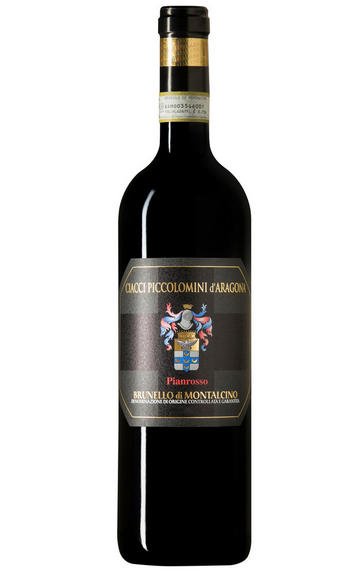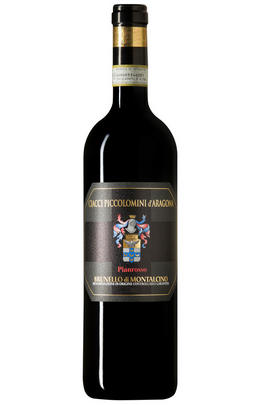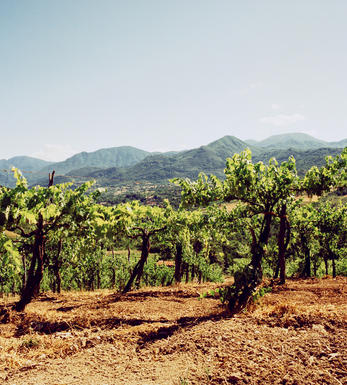
2017 Brunello di Montalcino, Pianrosso, Ciacci Piccolomini d'Aragona, Tuscany, Italy

Critics reviews
A nuanced, delicate bouquet of dried strawberries, roses, hints of sweet spice and crushed rocks lifts up from the charming 2017 Brunello di Montalcino Pianrosso. This is remarkably lifted, yet juicy and energetic, as ripe red berries and minerals cascade across the palate. It leaves a coating of violet-tinged florals, along with persistent raspberry and cherry tones. The tannin management here is absolutely stunning, as the Pianrosso finishes structured yet vividly fresh.
Drink 2024 - 2027
Eric Guido, vinous.com (Dec 2021)
The Ciacci Piccolomini d'Aragona 2017 Brunello di Montalcino Pianrosso shows nice balance and elegance, and it definitely shows the deft hand of the winemaking team in what was not an easy vintage by any stretch. This pretty wine delivers lots of fresh cherry and wild rose, with ferrous earthy, licorice and grilled herb; I also get bay leaf and rosemary sprig. Like the annata 2017 Brunello produced by this estate, the single-vineyard Brunello Pianrosso is distinguished by a sweet cherry note (plus a hefty 15% alcohol) that accompanies the wine from start to finish. Production is 37,000 bottles.
Drink 2024 - 2042
Monica Larner, Wine Advocate (Feb 2022)
This is a beautifully crafted and polished Brunello for this vintage, with full body and creamy, lightly chewy tannins. Dark berries, walnuts and cedar with dried-flower undertones. Needs time to soften, but very pretty. Drink after 2024.
James Suckling, jamessuckling.com (Oct 2021)
Ciacci Piccolomini’s 12ha flagship vineyard, Pianrosso sits above the Orcia river between 240 and 360 metres. It is consistently caressed by sea breezes which surface in the afternoon. The lavish warmth of this southern zone is palpable in the heady 15% alcohol and soft, laidback acidity. Nevertheless, there is focus and liveliness. Orange blossom and persimmon aromas lead to flavours of toothsome red plum and an attractive lingering bergamot finish. While immediate and accessible with mellow tannins, there is enough substance to carry this 2017 for another five years.
Drink 2022 - 2027
Michaela Morris, Decanter.com (Nov 2021)
About this WINE

Ciacci Piccolomini d'Aragona
Located in the south east of the Montalcino region close to the beautiful medieval village of Castelnuovo dell’Abate, the estate of Ciacci Piccolomini d’Aragona can trace its roots back to the 17th century. The Ciacci family owned the estate for over a hundred years until the death of Countess Elda Ciacci in 1985.
As the Countess had no children, she left the property to her long standing and well-respected estate manager Giuseppe Bianchini. His hard work and dedication have been continued by his son and daughter, Paolo and Lucia, who have developed the property and wines to their current respected position.
They have a total holding of 220 hectares of the rolling Tuscan hills bordered by the Orcia River which helps moderate the temperature of this hot and dry part of the region. 53 hectares are devoted to the wonderful Sangiovese Grosso grape which produce the Brunello di Montalcino together with small amounts of Merlot and Cabernet Sauvignon.

Brunello di Montalcino
Along with Chianti, Brunello di Montalcino is Tuscany's most famous DOCG and the region's boldest expression of Sangiovese. Located 30 miles south of Siena with the hilltop town of Montalcino as its epicentre, its 2,000 hectares of vines are naturally delimited by the Orcia, Asso and Ombrone valleys. Brunello is the local name for the Sangiovese Grosso clone from which Brunello di Montalcino should be made in purezza (ie 100 percent).
The Brunello di Montalcino DOCG has a whale-like shape: at its head, at 661 metres above sea level on ancient, stony galestro soils facing east and southeast lies the town of Montalcino, where the DOC was founded. As you follow the spine south towards the tail, the vineyards lose altitude – those around Colle Sant'Angelo are at 250 metres – while the soils become richer with iron and clay. Further east, in the shadow of the 1,734 metre Mont'Amiata lies the village of Castelnuovo dell'Abate where the vineyards are strewn with a rich mix of galestro, granitic, volcanic, clay and schist soil types.
Historically, the zone is one of Tuscany's youngest. First praised in 1550 by Leandro Alberti for the quality of its wines, it was Tenuta Il Greppo who bottled the inaugural Brunello di Montalcino in 1888. By 1929, the region had 925 hectares of vines and 1,243 hectares of mixed crops, while in 1932 it was decreed that only those wines made and bottled within the commune could be labelled as Brunello di Montalcino. Since then, the number of producers has risen from 11 in 1960 to 230 in 2006, while over the same period the vineyards have expanded from 1,000 hectares to 12,000. The region earned its DOC in 1966, and was upgraded to DOCG in 1980.
Brunello di Montalcino cannot be released for sale until five years after the harvest, or six years in the case of Brunello di Montalcino Riserva. During this time the wines should be aged for at least two years in oak, followed by at least four months in bottle (six months for Riservas); maximum yields are 55 hl/ha.
Rosso di Montalcino is declassified Brunello di Montalcino, released for sale 18 months after the harvest.
Recommended producers: Costanti, Fuligni, Lisini, San Giuseppe, Soldera, Cerbaiona

Sangiovese
A black grape widely grown in Central Italy and the main component of Chianti and Vino Nobile di Montepulciano as well as being the sole permitted grape for the famed Brunello di Montalcino.
It is a high yielding, late ripening grape that performs best on well-drained calcareous soils on south-facing hillsides. For years it was blighted by poor clonal selection and massive overcropping - however since the 1980s the quality of Sangiovese-based wines has rocketed upwards and they are now some of the most sought after in the world.
It produces wines with pronounced tannins and acidity, though not always with great depth of colour, and its character can vary from farmyard/leather nuances through to essence of red cherries and plums. In the 1960s the advent of Super Tuscans saw bottlings of 100% Sangiovese wines, as well as the introduction of Sangiovese/Cabernet Sauvignon blends, the most famous being Tignanello.


Buying options
Add to wishlist
Description
A nuanced, delicate bouquet of dried strawberries, roses, hints of sweet spice and crushed rocks lifts up from the charming 2017 Brunello di Montalcino Pianrosso. This is remarkably lifted, yet juicy and energetic, as ripe red berries and minerals cascade across the palate. It leaves a coating of violet-tinged florals, along with persistent raspberry and cherry tones. The tannin management here is absolutely stunning, as the Pianrosso finishes structured yet vividly fresh.
Drink 2024 - 2027
Eric Guido, vinous.com (Dec 2021)
wine at a glance
Delivery and quality guarantee